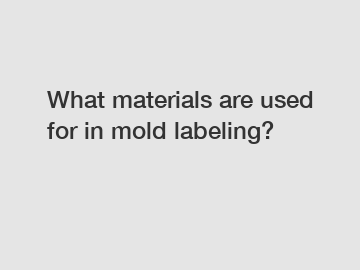What materials are used for in mold labeling?
What materials are used for in-mold labeling?
In-mold labeling (IML) is a popular method of decorating molded plastic products. It involves placing pre-printed labels into the mold before the plastic is injected, resulting in a seamless and long-lasting design. This process offers numerous advantages, including increased durability, improved aesthetics, and cost efficiency. However, to ensure successful in-mold labeling, it is essential to use the right materials. In this article, we will explore the different materials commonly used for in-mold labeling.
1. Label materials:

In-mold labels are made from a variety of materials, each offering distinct characteristics and benefits. Some of the most commonly used label materials for IML include:
.
- Polypropylene (PP): PP labels are highly versatile and suitable for a wide range of applications. They are resistant to chemicals, moisture, and UV radiation, making them ideal for products that may be exposed to harsh environments. PP labels also have good heat resistance, which is crucial during the injection molding process.
- Polyethylene (PE): PE labels are known for their excellent adhesion to plastic substrates. They offer good flexibility and conformability, making them perfect for complex-shaped products. PE labels are commonly used in the food and beverage industry due to their food-contact safety certification.
- Synthetic paper: Synthetic paper labels are tear-resistant and waterproof, making them highly durable. They provide excellent print quality and are suitable for outdoor applications. Synthetic paper labels can withstand extreme temperatures, making them a popular choice for automotive parts and appliances.
- Vinyl: Vinyl labels are known for their high flexibility and excellent adhesion to a variety of substrates. They are resistant to chemicals and UV radiation, making them suitable for outdoor applications. Vinyl labels also offer a wide range of printing options, including metallic and fluorescent colors.
2. Adhesive materials:
To ensure proper bonding between the label and the plastic substrate, high-quality adhesive materials are essential. The choice of adhesive depends on factors such as the label material, product usage, and environmental conditions. Some commonly used adhesive materials for in-mold labeling include:
- Hot melt adhesives: These adhesives are applied to the back of the label in a molten state during the in-mold labeling process. They provide instant bonding and exhibit good heat resistance. Hot melt adhesives are versatile and can be used with a wide range of label materials.
- Pressure-sensitive adhesives (PSAs): PSAs are pre-applied to the labels, allowing for easy application during the in-mold labeling process. They offer excellent adhesion to various substrates and are available in both permanent and removable options. PSAs provide good performance at both low and high temperatures.
3. Ink materials:
In-mold labeling requires high-quality inks that can withstand the molding process and maintain their vibrancy. Some common ink options for in-mold labeling include:
- UV-curable inks: These inks are widely used for in-mold labeling due to their excellent adhesion to different label materials and high resistance to chemicals, moisture, and UV radiation. UV-curable inks dry instantly when exposed to UV light, resulting in a durable and scratch-resistant label.
- Solvent-based inks: Solvent-based inks offer good adhesion to a variety of substrates and provide vibrant colors. They are suitable for both indoor and outdoor applications. However, they require proper ventilation during the drying process due to their high solvent content.
In conclusion, the materials used for in-mold labeling play a crucial role in achieving a successful and long-lasting result. Label materials such as polypropylene, polyethylene, synthetic paper, and vinyl offer different characteristics to suit various applications. Adhesive materials, including hot melt adhesives and pressure-sensitive adhesives, ensure proper bonding between the label and the plastic substrate. Finally, ink materials like UV-curable inks and solvent-based inks provide vibrant and durable printing options. By selecting the right materials for in-mold labeling, manufacturers can enhance their products' visual appeal, durability, and overall value.
For more information about in-mold labeling materials and processes, please contact us.
If you want to learn more, please visit our website iml plastic container manufacturers, 125ml Ice Cream Container Wholesale, square ice cream containers.



Comments
0